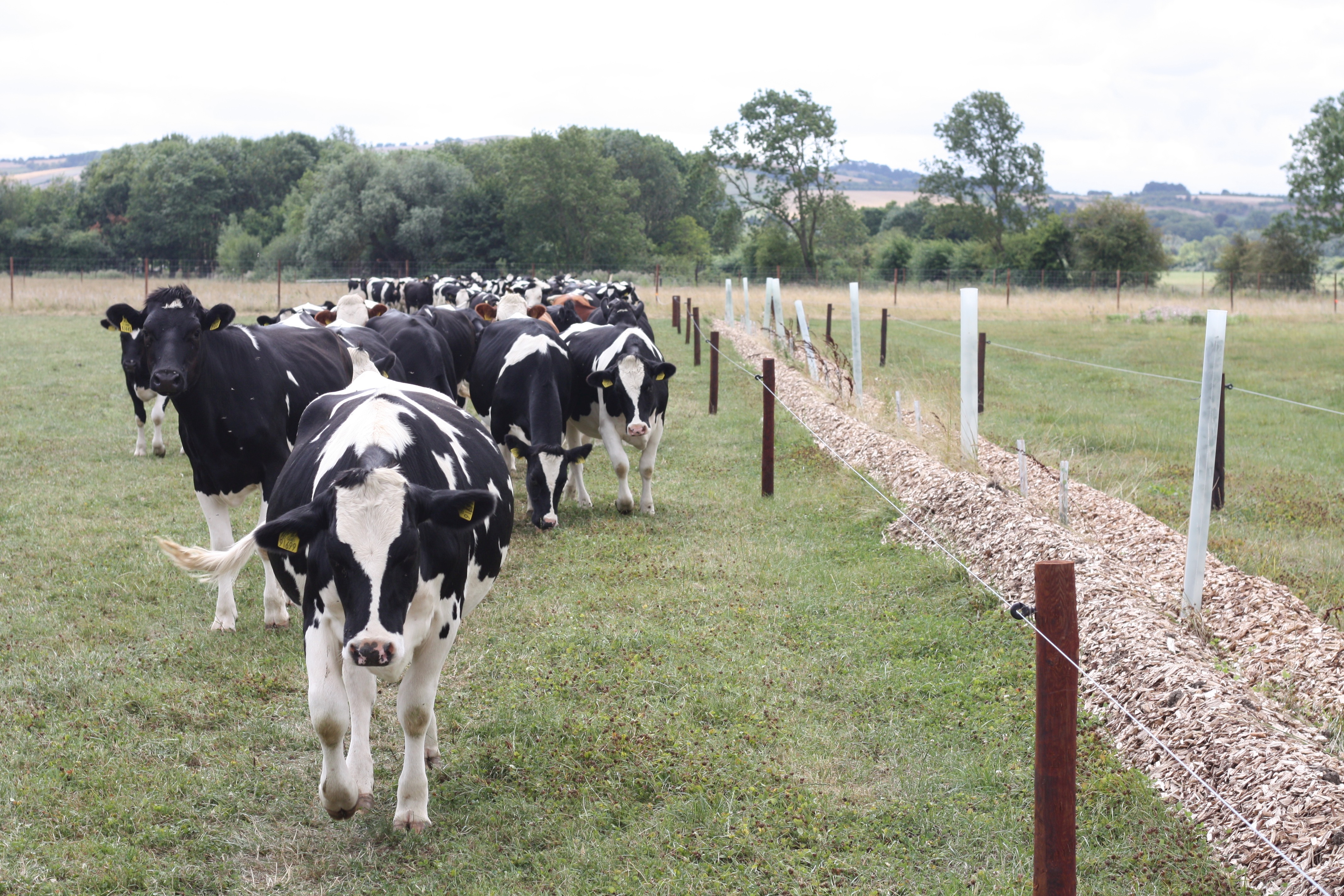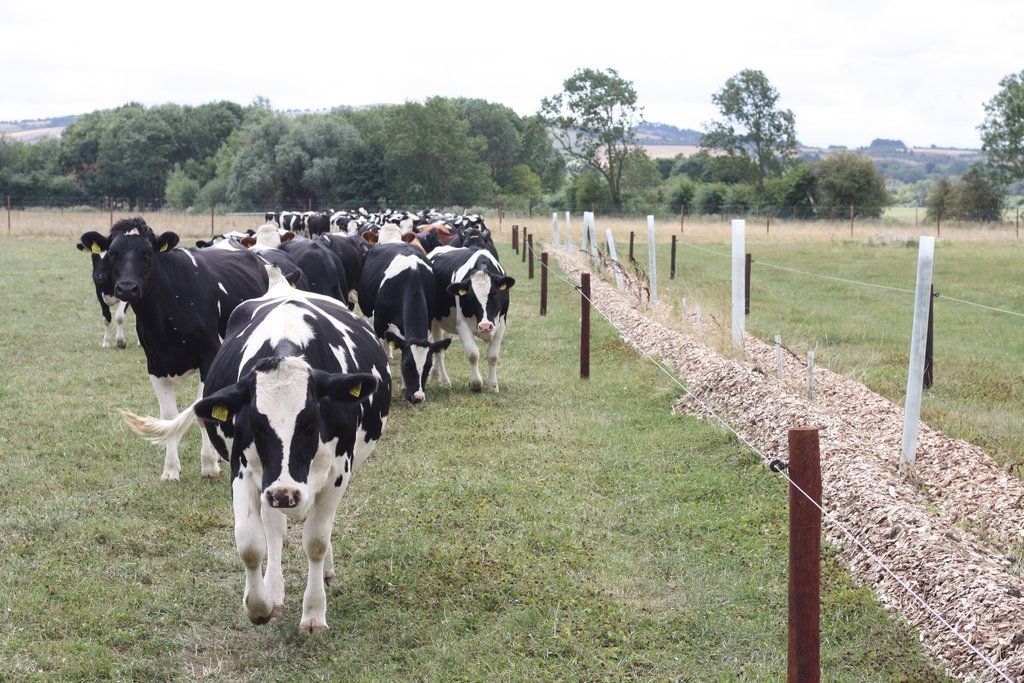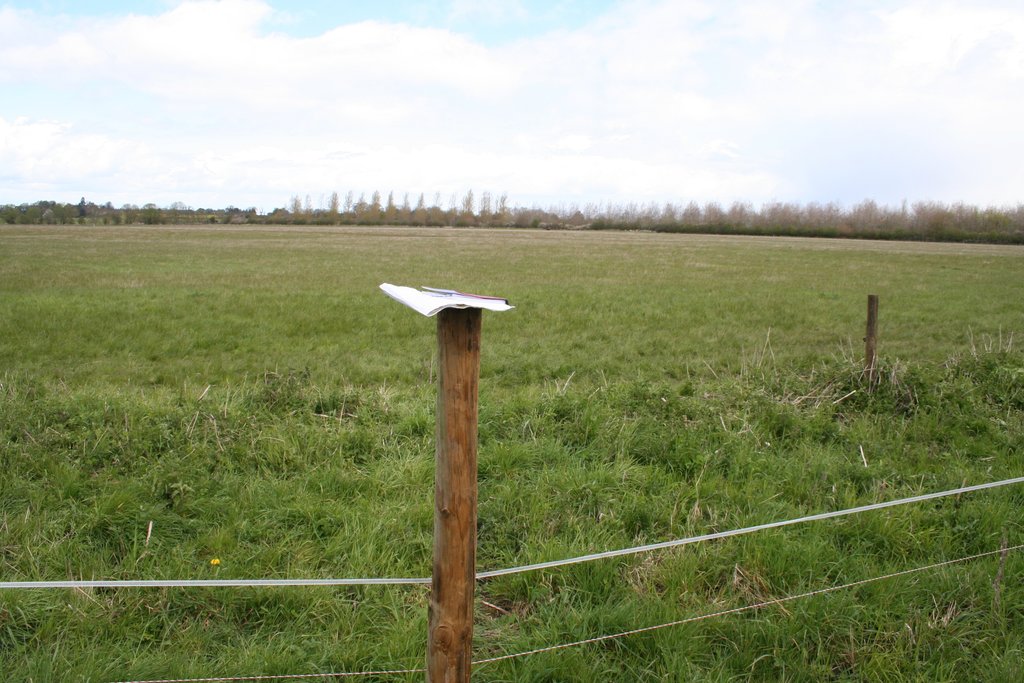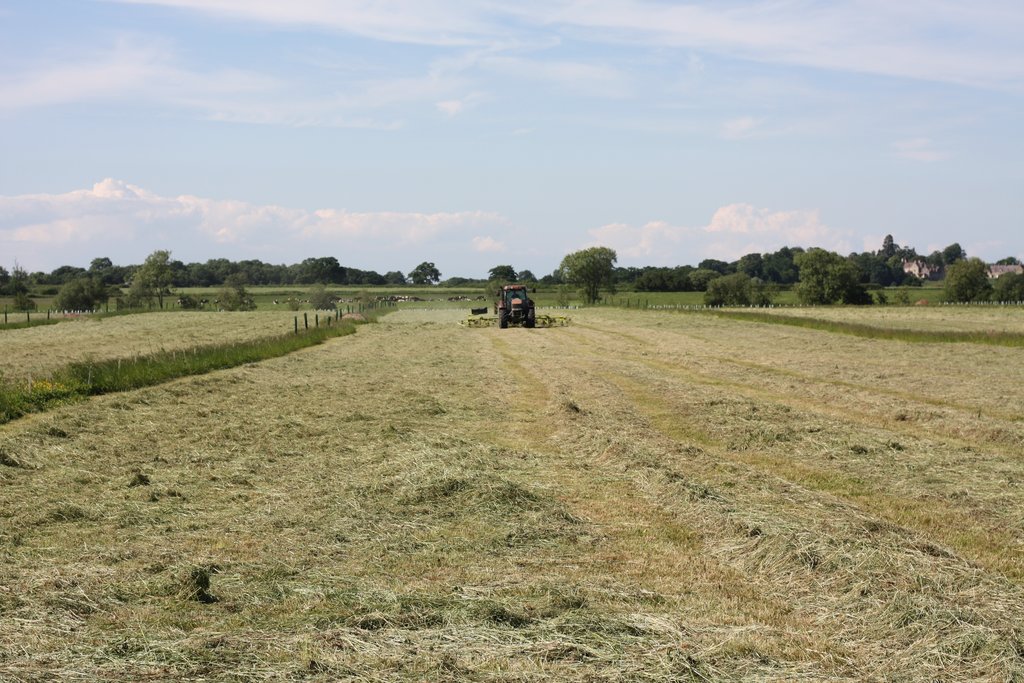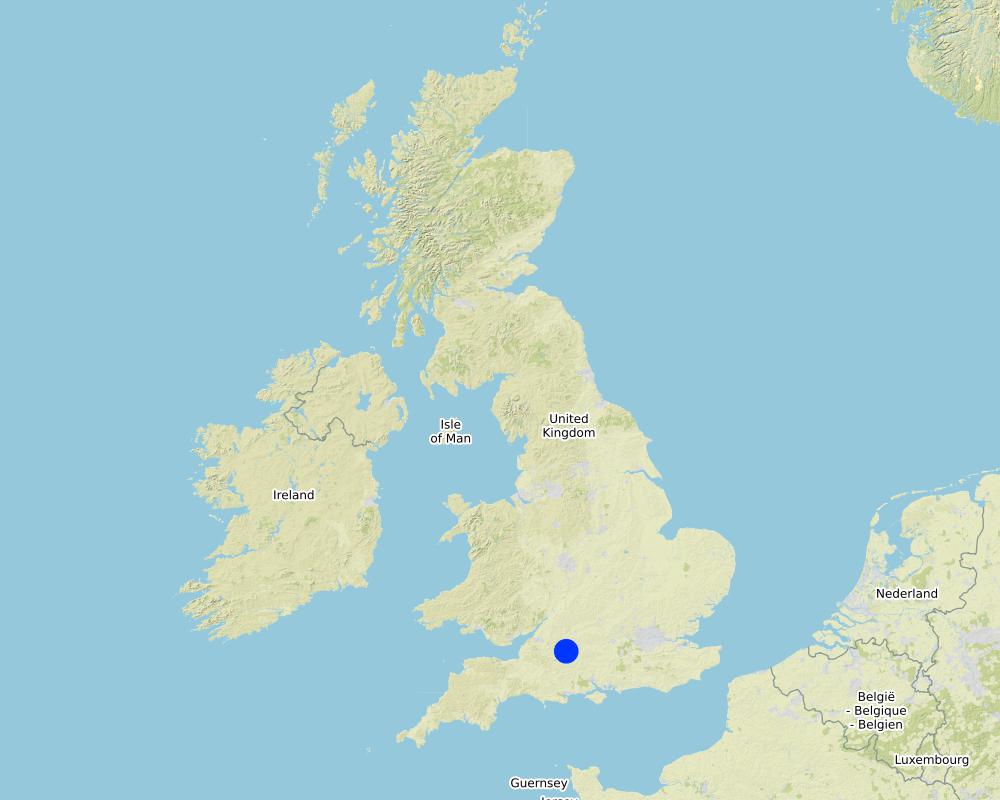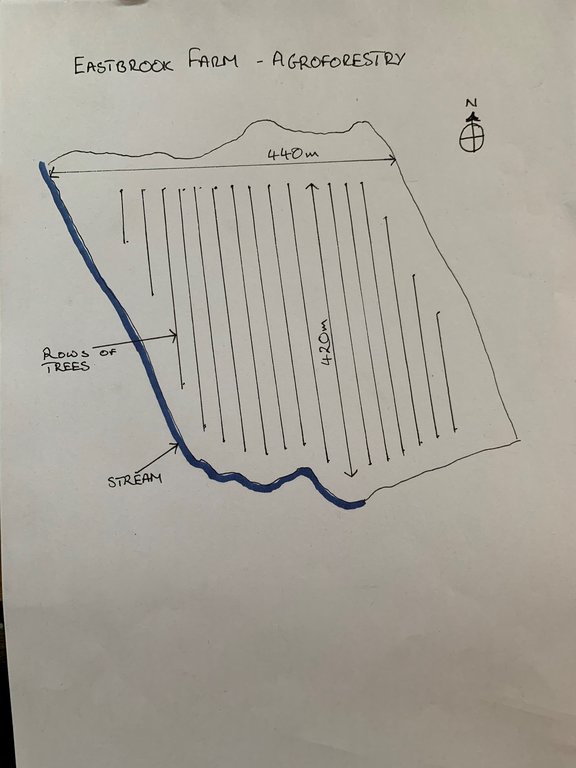Silvopastoral Agroforestry – Perry pears and timber with mob grazed young dairy stock [United Kingdom]
- Creation:
- Update:
- Compiler: Alan Radbourne
- Editors: David Robinson, David Norris, Sabine Reinsch
- Reviewers: Ursula Gaemperli, Rima Mekdaschi Studer
Silvopastoral Agroforestry – Perry pears and timber with mob grazed young dairy stock
technologies_5186 - United Kingdom
View sections
Expand all Collapse all1. معلومات عامة
1.2 Contact details of resource persons and institutions involved in the assessment and documentation of the Technology
Key resource person(s)
SLM specialist:
Raskin Ben
Soil Association
United Kingdom
land user:
Browning Helen
Eastbrook Farm
United Kingdom
Name of project which facilitated the documentation/ evaluation of the Technology (if relevant)
European Interreg project FABulous Farmers1.3 Conditions regarding the use of data documented through WOCAT
The compiler and key resource person(s) accept the conditions regarding the use of data documented through WOCAT:
نعم
1.4 Declaration on sustainability of the described Technology
Is the Technology described here problematic with regard to land degradation, so that it cannot be declared a sustainable land management technology?
لا
2. Description of the SLM Technology
2.1 Short description of the Technology
Definition of the Technology:
Silvopastoral Agroforestry in a natural farmed environment – This is an alley cropping system with rows of Perry pears and timber trees inter-planted with coppiced willow and alder. The pasture in between the rows is mob grazed with young dairy stock.
2.2 Detailed description of the Technology
Description:
Background: The agroforestry system is part of a mixed farm of 630 hectares. 550 hectares are rented on a three generation tenancy. The farmer is the second generation. The trees are planted on the 80 hectares owned by the farmer. The annual rainfall for the region is approximatly 630mm per year with a typical temperate UK climate. The soil is heavy clay on a flat landscape.
The system: The field is 19 hectares. The trees are planted in rows which are 27 m apart. There is a main species in each row, planted at 10 m spacing. These are inter-planted with smaller trees, or species that will be coppiced/pollarded to maintain a small form. The main species are: Perry pear (a small pear that is a cross between Pyrus communis and its wild subsp. pyraster – used to make the alcoholic drink “Perry”). We have also some species planted for timber Quercus robur, Sorbus torminalis, Carpinus betula, Prunus avium. The inter-plant species are Salix various sp., Alnus glutinosa. These will be used either for animal fodder or for chipping and used as a mulch or for spreading on the land as soil health improver. There are also some Hippophae rhamnoides for human consumption. The alleys between the rows of trees are grazed by young dairy stock on a mob grazing rotational basis.
Aims: The aim is to improve soil and drainage in the field which is heavy clay. We hope to improve productivity but also have designed the system that we can grow crops in the future if we wanted to. The trees will also provide benefit to the cows through shelter and shade, and the inter-plants of willow and alder grow through diverse forage.
Tree protection: Fencing was our major challenge. There needed to be protection from the livestock but also from wildlife (in particular deer and hares). Our initial trial used individual guards and stakes but we have since fenced each side of each row with a single strand of electric fencing. This is working well.
Benefits: This is newly planted but already we are seeing improvement in the grass ley through our rotational grazing. Water quality into the nearby stream and infiltration improved and flooding should also improve. We have seen an immediate increase in wildlife with greater numbers of hares, raptors (including kestrels, red kites and buzzards), and butterflies. The farm manager likes the ability to mob graze, although the system was complicated to set up. It is too early to comment on further benefits at this stage.
2.3 Photos of the Technology
2.5 Country/ region/ locations where the Technology has been applied and which are covered by this assessment
بلد:
United Kingdom
Region/ State/ Province:
South West
Further specification of location:
Wiltshire
Specify the spread of the Technology:
- evenly spread over an area
If the Technology is evenly spread over an area, specify area covered (in km2):
0,19
If precise area is not known, indicate approximate area covered:
- 0.1-1 km2
Is/are the technology site(s) located in a permanently protected area?
لا
Comments:
Eastbrook Farm, Bishopstone, Wiltshire, Helen Browning Organics
Latitude 51.566424, Longitude 1.668787
Map
×2.6 Date of implementation
Indicate year of implementation:
2017
2.7 Introduction of the Technology
Specify how the Technology was introduced:
- through land users' innovation
3. Classification of the SLM Technology
3.1 Main purpose(s) of the Technology
- improve production
- protect a watershed/ downstream areas – in combination with other Technologies
- mitigate climate change and its impacts
- create beneficial economic impact
- improve animal welfare
3.2 Current land use type(s) where the Technology is applied
Land use mixed within the same land unit:
نعم
Specify mixed land use (crops/ grazing/ trees):
- Silvo-pastoralism

أراضي الرعي
Intensive grazing/ fodder production:
- Improved pastures
Animal type:
- cattle - dairy and beef (e.g. zebu)
Is integrated crop-livestock management practiced?
نعم
If yes, specify:
Silvo-pastoral system where pear trees grown in rows allowing for cattle pasture grazing in between.
Products and services:
- meat
- milk
Species:
cattle - dairy and beef (e.g. zebu)
Count:
100

Forest/ woodlands
- Tree plantation, afforestation
Tree plantation, afforestation: Specify origin and composition of species:
- Mixed varieties
Type of tree plantation, afforestation:
- temperate continental forest plantation
- Perry Pear,Quercus robur, Sorbus torminalis, Carpinus betula, Prunus avium.
Are the trees specified above deciduous or evergreen?
- deciduous
Products and services:
- Timber
- Fruits and nuts
3.3 Has land use changed due to the implementation of the Technology?
Has land use changed due to the implementation of the Technology?
- Yes (Please fill out the questions below with regard to the land use before implementation of the Technology)
Land use mixed within the same land unit:
لا

أراضي الرعي
Intensive grazing/ fodder production:
- Improved pastures
Animal type:
- cattle - dairy and beef (e.g. zebu)
Is integrated crop-livestock management practiced?
لا
Products and services:
- meat
- milk
Species:
cattle - dairy and beef (e.g. zebu)
Count:
100
3.4 Water supply
Water supply for the land on which the Technology is applied:
- rainfed
Comments:
Trees not irrigated. Cattle mainly by water troughs.
3.5 SLM group to which the Technology belongs
- agroforestry
- integrated crop-livestock management
3.6 SLM measures comprising the Technology

vegetative measures
- V1: Tree and shrub cover

management measures
- M2: Change of management/ intensity level
3.7 Main types of land degradation addressed by the Technology

chemical soil deterioration
- Cn: fertility decline and reduced organic matter content (not caused by erosion)

physical soil deterioration
- Pw: waterlogging
3.8 Prevention, reduction, or restoration of land degradation
Specify the goal of the Technology with regard to land degradation:
- reduce land degradation
4. Technical specifications, implementation activities, inputs, and costs
4.1 Technical drawing of the Technology
Technical specifications (related to technical drawing):
The field has an area of 19 hectares with north to south rows of trees of up to 420m length and across a 440m field. The field is adjacent to stream and has no slope. The trees are planted in rows with a within row spacing of 10 m and between row spacing of 27 m . The main species planted is perry pear
Author:
Ben Raskin
Date:
21/10/2020
4.2 General information regarding the calculation of inputs and costs
Specify how costs and inputs were calculated:
- per Technology area
Indicate size and area unit:
19 hectares
If using a local area unit, indicate conversion factor to one hectare (e.g. 1 ha = 2.47 acres): 1 ha =:
1 ha = 2.47 acres
other/ national currency (specify):
British pound
If relevant, indicate exchange rate from USD to local currency (e.g. 1 USD = 79.9 Brazilian Real): 1 USD =:
0,73
Indicate average wage cost of hired labour per day:
Approx. £150
4.3 Establishment activities
| Activity | Timing (season) | |
|---|---|---|
| 1. | Trench dug with tillage machinery to plant each row of trees | Autumn |
| 2. | Tree standards (bought from tree nursery) planted by hand in trench spaces 2m apart | Winter |
| 3. | Fencing installed by hand as single strand electric along either side of each row of trees | Spring |
| 4. | Mulch added to base of trees using tractor to surpress weeds, provide fertiliser and keep moisture in soil | Spring |
4.4 Costs and inputs needed for establishment
If you are unable to break down the costs in the table above, give an estimation of the total costs of establishing the Technology:
14500,0
4.5 Maintenance/ recurrent activities
| Activity | Timing/ frequency | |
|---|---|---|
| 1. | Mulching each year at base of trees | Yearly (first 3 years) |
| 2. | Strimming grass and weeds between trees where livestock are exluded from area by fencing | Yearly (first 5 years) |
| 3. | Light pruning or training by hand where required | Yearly (first 5 years) |
4.6 Costs and inputs needed for maintenance/ recurrent activities (per year)
If you are unable to break down the costs in the table above, give an estimation of the total costs of maintaining the Technology:
1500,0
4.7 Most important factors affecting the costs
Describe the most determinate factors affecting the costs:
Type of tree, type of fencing and weather related impacts.
5. Natural and human environment
5.1 Climate
Annual rainfall
- < 250 mm
- 251-500 mm
- 501-750 mm
- 751-1,000 mm
- 1,001-1,500 mm
- 1,501-2,000 mm
- 2,001-3,000 mm
- 3,001-4,000 mm
- > 4,000 mm
Agro-climatic zone
- semi-arid
5.2 Topography
Slopes on average:
- flat (0-2%)
- gentle (3-5%)
- moderate (6-10%)
- rolling (11-15%)
- hilly (16-30%)
- steep (31-60%)
- very steep (>60%)
Landforms:
- plateau/plains
- ridges
- mountain slopes
- hill slopes
- footslopes
- valley floors
Altitudinal zone:
- 0-100 m a.s.l.
- 101-500 m a.s.l.
- 501-1,000 m a.s.l.
- 1,001-1,500 m a.s.l.
- 1,501-2,000 m a.s.l.
- 2,001-2,500 m a.s.l.
- 2,501-3,000 m a.s.l.
- 3,001-4,000 m a.s.l.
- > 4,000 m a.s.l.
Indicate if the Technology is specifically applied in:
- not relevant
5.3 Soils
Soil depth on average:
- very shallow (0-20 cm)
- shallow (21-50 cm)
- moderately deep (51-80 cm)
- deep (81-120 cm)
- very deep (> 120 cm)
Soil texture (topsoil):
- fine/ heavy (clay)
Soil texture (> 20 cm below surface):
- fine/ heavy (clay)
Topsoil organic matter:
- high (>3%)
5.4 Water availability and quality
Ground water table:
< 5 m
Water quality refers to:
ground water
Is water salinity a problem?
لا
Is flooding of the area occurring?
نعم
Regularity:
episodically
Comments and further specifications on water quality and quantity:
Surface water flooding due to poor drainage, one aim of intervention is to help improve this.
5.5 Biodiversity
Species diversity:
- medium
Habitat diversity:
- medium
5.6 Characteristics of land users applying the Technology
Sedentary or nomadic:
- Sedentary
Market orientation of production system:
- mixed (subsistence/ commercial)
Off-farm income:
- less than 10% of all income
Relative level of wealth:
- average
Individuals or groups:
- individual/ household
Level of mechanization:
- mechanized/ motorized
Gender:
- women
- men
Age of land users:
- middle-aged
5.7 Average area of land used by land users applying the Technology
- < 0.5 ha
- 0.5-1 ha
- 1-2 ha
- 2-5 ha
- 5-15 ha
- 15-50 ha
- 50-100 ha
- 100-500 ha
- 500-1,000 ha
- 1,000-10,000 ha
- > 10,000 ha
Is this considered small-, medium- or large-scale (referring to local context)?
- large-scale
Comments:
The agroforestry system is part of a mixed farm of 630 hectares
5.8 Land ownership, land use rights, and water use rights
Land ownership:
- individual, not titled
Land use rights:
- leased
Water use rights:
- leased
Are land use rights based on a traditional legal system?
نعم
حددها:
550 hectares rented, 80 hectares owned by the farmer
5.9 Access to services and infrastructure
health:
- poor
- moderate
- good
education:
- poor
- moderate
- good
technical assistance:
- poor
- moderate
- good
employment (e.g. off-farm):
- poor
- moderate
- good
markets:
- poor
- moderate
- good
energy:
- poor
- moderate
- good
roads and transport:
- poor
- moderate
- good
drinking water and sanitation:
- poor
- moderate
- good
financial services:
- poor
- moderate
- good
6. Impacts and concluding statements
6.1 On-site impacts the Technology has shown
Socio-economic impacts
Production
fodder production
Comments/ specify:
Slight improvement in productivity of grassland due to rotational grazing between the trees.
product diversity
Comments/ specify:
Currently still too early for full pear harvest, yet in time the return with product diversification will be of great benefit to farm diversification and sustainability.
Income and costs
diversity of income sources
Comments/ specify:
Currently still too early for full pear harvest, yet in time the return with product diversification will be of great benefit to farm diversification and sustainability.
Socio-cultural impacts
recreational opportunities
Comments/ specify:
Visitors coming to learn about Agroforestry has provided an opportunity to engage the interested general public and share knowledge.
Ecological impacts
Climate and disaster risk reduction
flood impacts
Comments/ specify:
Slight reduction in standing water during periods of high rainfall
6.2 Off-site impacts the Technology has shown
Specify assessment of off-site impacts (measurements):
N/A
6.3 Exposure and sensitivity of the Technology to gradual climate change and climate-related extremes/ disasters (as perceived by land users)
Gradual climate change
Gradual climate change
| Season | increase or decrease | How does the Technology cope with it? | |
|---|---|---|---|
| seasonal temperature | summer | increase | well |
| seasonal rainfall | summer | increase | well |
6.4 Cost-benefit analysis
How do the benefits compare with the establishment costs (from land users’ perspective)?
Short-term returns:
neutral/ balanced
How do the benefits compare with the maintenance/ recurrent costs (from land users' perspective)?
Short-term returns:
neutral/ balanced
Comments:
Technology very recently implemented so cost-benefit is still unknown. Currnetly not viewed negitivly, yet benefits are still to be understood.
6.5 Adoption of the Technology
- single cases/ experimental
Of all those who have adopted the Technology, how many did so spontaneously, i.e. without receiving any material incentives/ payments?
- 91-100%
6.6 التكيف
Has the Technology been modified recently to adapt to changing conditions?
لا
6.7 Strengths/ advantages/ opportunities of the Technology
| Strengths/ advantages/ opportunities in the land user’s view |
|---|
| Change in grazing regime from large pasture to rotational grazing between tree lines has additional benefits for improved pasture and animal wealfare with less requirement to worm using antibiotics. |
| Initial observations of improved water infiltration due to better infiltration by trees rooting system |
| Strengths/ advantages/ opportunities in the compiler’s or other key resource person’s view |
|---|
| Future opportunity of land and business diversification |
| Increase in biodiversity evident already and would expect further improvements. |
6.8 Weaknesses/ disadvantages/ risks of the Technology and ways of overcoming them
| Weaknesses/ disadvantages/ risks in the land user’s view | How can they be overcome? |
|---|---|
| Tree loss due to weather extremes (i.e. loss of young tree stock in 2018 summer drought) | Mulching, irrigation, earlier planting, improved placement of tree stock on edge of sub-soil slot where less soil drying occurs compared to centre of slot. |
| Perenial weed control poor using just wood chip mulch | Increased strimming management of the growth around trees where livestock cannot reach due to fencing. |
| Time investment against other commitments (i.e. priority of broader farm systems when attention to new technology is required) | Forward planning and improved communcation between the farm team is vital to ensure a sufficient amount of time is provided for attending to and learning about a new technology. |
| Weaknesses/ disadvantages/ risks in the compiler’s or other key resource person’s view | How can they be overcome? |
|---|---|
| Overall costs against short-term return | Secure funding to enable longer-term return. |
7. References and links
7.1 Methods/ sources of information
- interviews with land users
1
- interviews with SLM specialists/ experts
1
When were the data compiled (in the field)?
08/10/2020
Comments:
Ongoing discussions with farmer and agroforestry expert overseeing the project have developed this SLM data input. Date of last meeing to finalise information listed above.
Links and modules
Expand all Collapse allLinks
No links
Modules
No modules


